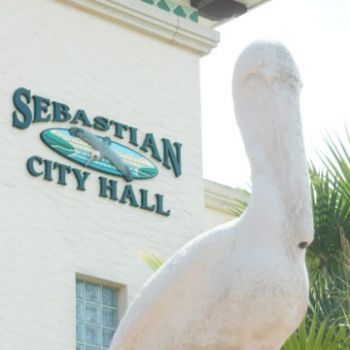
SEBASTIAN — Eliminating furloughs for Sebastian employees and replacing the city’s troublesome computer system are two major items in the proposed city budget, unveiled last week by Budget Advisory Chairman Ed Herlihy and City Manager Al Minner to the City Council.
“It is very close to last year with some positive exceptions,” Herlihy told council members when outlining the Advisory Board’s recommendation for a $21.2 million budget.
Herlihy also gave special emphasis to the payback of “seed money” to the general fund from the Building Department, using “much better than expected” department revenues.
“We strongly urge that we not use any reserve,” Herlihy emphasized, adding the general fund reserve would reach $4.44 million by late September. “We need it for a rainy day. Let’s keep it.”
Herlihy also stressed his board’s recommendation to eliminate the furlough – mandated unpaid days off, which have been scheduled for the last Friday of each month.
Several new programs are being introduced, including adjustments in personnel wages and benefits. With a new Employees First campaign, improving wages and benefits will be a priority before making other expense modifications with new revenues.
A new revenue sharing formula and additional items to discuss during the collective bargaining process are also planned.
“We are close to catching up with the can we’re kicking down the road,” said City Manager Al Minner, who explained the budget’s title, “Catching the Can,” before narrating a PowerPoint budget breakdown.
The budget includes seven major Components:
- Personnel services, including all payroll costs account for 38.58 percent of it.
- The operating budget – contractual fees, supplies, utilities, training/travel expenses – eats up about 19 percent.
- Transfers among budgeted funds account for 18 percent, while capital expenditures: equipment, facilities and land, construction of facilities such as roads, drainage and park projects are about 14.5 percent of the spending plan.
- And reserves, grants and debt service account for the remainder.
The general fund is $9.765 million, up about a quarter-percent from this fiscal year.
Public Safety takes the biggest slice – $4 million or 42 percent – followed by Public Works with $3.26 million or 33 percent; and Administration runs $1,36 million. Regulatory and non-departmental expenses make up the remaining 11 percent.
Eliminating furloughs would create a slight up-tick in personnel expenditure trends, but still be below what was spent in fiscal years 2010 and 2011 and remain relatively level.
Operating and capital expenditures remain generally flat.
Another major new budget addition will be upgrades and improvements to the IT department, coming in at $250,000.
A recent network assessment revealed four major weaknesses which are already being addressed: bandwidth has been upgraded, security has been improved, the IT network manager position has been upgraded and a new IT systems analyst position has been proposed.
“We don’t want to fall back in the hole,” said Herlihy.
New in the operating budget is a $100,000 allocation for swale and ditch maintenance.
Herlihy commented on the $215,000 police equipment replacement item (vehicles), which he said is absolutely necessary in spite of what might be inferred by observing the police department parking lot.
He said that the current “hot car system” is extremely hard on vehicles.
That term refers to a single car being used from shift to shift, coming in with one driver and immediately back out on the road with another officer for the next shift, pretty much 24-7.
Instead, Herlihy explained, assigning a specific vehicle to a specific officer will result in better maintenance and less wear and tear, thus extending the service life of the vehicle.
Revenue growth of $324,500 will result from utility service taxes, $111,400; state shared revenues, $113,100, and returns business tax, $100,000.
Property taxes provide approximately 29.3 percent of the city’s general fund revenues.
Although the FY 2013/14 property value (determined by the county property appraiser) shows a decrease of .61 percent, new construction and improvements offset that dip, resulting in additional tax revenues at the same rate as last year, $3.7116 per $1,000 of value.
Total revenues amount to $21.2 million.
The city’s enterprise funds – the golf course, the airport and the Building Department – are fed by the users of their services.
Golf course revenues have held fairly steady since FY2010.
The airport continues to see positive growth, and significant new job creation among its tenants. Two new projects, Airport Drive East and a natural gas line along Roseland Road are current Economic Development Division primary goals.
The Building Department, recovering from losses up through FY2012 is seeing new revenue and a positive growth trend.
Plans for FY2014 include transfer of business tax back to the general fund and a proposed new position – permit technician.
Council Member Andrea Coy expressed concern about what she views as an unacceptable lack of staff.
“When do you see us bringing people back?” she asked. “We’ve been promising the police chief (more staff ) year after year after year.”
More growth has to happen first, Minner responded.
“A couple more years out – 2016 or 17,” he said. “Now, we’re doing more for less. To replace personnel, I’d have to go back to the millage rate.”
“Someone (additional on staff) could be out there looking for grant money,” Coy pressed.
The final budget hearing and adoption will take place at the regular City Council meeting, 6:30 p.m., Wednesday, Sept. 26.



